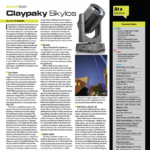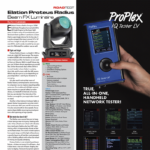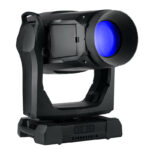The physical size of the Stormy appears to be that of that old strobe, but on steroids. The stormy has a two-inch strip of PCB that is fitted right in the center of the reflector. Each side of the PCB is equipped with a whopping 72 individual 7W Oslon Osram LEDs, 144 total.
 All-White/Color LED Options
All-White/Color LED Options
The all-white fixture has 144 white LEDs, while the Stormy CC alternates Red, Green, Blue and White LEDs. Rather than have the physical LEDs pointed directly out the front of the fixture, Clay Paky has them pointed at the reflector on either side of the PC Board. This enables the strobe to emit maximum lumens.
The white strobe runs like any typical strobe. It can run in 3-channel mode, but I am running it in a mode, which requires seven DMX channels — the usual Intensity, strobe rate and strobe duration apply to this model. Other channels are used for built in macros that provide different effects such as ramped up Intensities and random chases, etc.
I am running the colorized version in 14-channel mode itself. I test them side-by-side. These fixtures can stay on at full, or strobe continually, without ever having to thermal out, it seems. I ran them for close to a minute until my retinas were too burnt to even be in the same room with the fixture. The all-white fixture is literally twice as bright as the RGBW one. The tech sheets reflect that as well, boasting that the all white Stormy emits 80,000 lumens compared to 40K with the colored LEDs. I would prefer to look directly into the sun rather than stare at the all-white version at full intensity.
By putting the Strobe duration and the strobe speed at full, I am essentially turning this fixture into a cyc light, capable of mixing colors and washing an entire stage easily. The fixture says it has a beam aperture of only 42°, but in layman’s terms, it’s throwing a huge wash all over this room. I would say the beam spread, when I use this fixture as a wash light, would be closer to 140°.
I have separate control of each of the four RGBW colored LEDs, which means I have separate color control, separate strobe rate and duration channels for each. As I test this fixture, I realize I am doing things I have never been able to do with other strobe fixtures on the market. I can set up the fixture to have a steady, flicker-free blue wash emitted. On top of that, I put the red channel on a slow strobe, where it just blinks a flash once every second. The end result is I have a blue wash light with a pink flash emulating out of the fixture, which is way cool in my book.
Lumens vs. Color Saturation
The one thing I notice is that the LEDs in the color version are not saturated colors. The Blue LED is closer to Cyan. The Green LED is a medium shade, as is the red. I am guessing this was done intentionally to get more lumens out of the fixture. But it also means fewer saturated colors to choose from. One cannot mix a deep blue, nor create a magenta hue, with this fixture. When you mix full red and blue together, you get a pink color. However, it works to the users advantage in other ways. For instance, taking all the colored LEDs to full gives me a very good white source. It is not a pure 5700° color temperature like the white LED’s emit, but it does not have the pink hue one would expect. I suspect dark hues in a strobe would prevent a lot of light from being emitted, so, all in all, I am pleased with the color mixing abilities.
I check out the dimmer curves. There are two separate modes. One appears to be a rock ‘n’ roll mode, as the light pops on as soon as my encoder wheel for the dimmer channel hits 2.5 percent. Then, by the time the dimmer is at 50 percent, the strobe is emitting full intensity. I check out the other mode, and it is very linear, from zero to full. I cannot slowly dim the LEDs up as smoothly as I would like without the pop, but I imagine that can be expected because of the massive amount of lumens this beauty emits when on at full.
There are a few other clever options when using this fixture. The user can set it in silent mode, turning the fans off. This limits the output of the strobe, but quiets the room. I can also set what they call a “Minimum TON Value,” where the user defines the minimum strobe duration time, and the console values cannot make the fixture go below that rate.
Physically, the fixture boasts an IP20 rating, so it is electrically safe, but should be kept away from water. It receives AC through the Neutrik powerCON True1 connector, which is rated at 30 amps and is good for direct-connecting under load. It is rated to use as a power switch, so you will not find a power button on the strobe itself. I am feeding it 110 volts. The body is made of anodized aluminum and the light weighs a mere 15 pounds. The yoke allows for mounting in any direction.
At a Glance
Powerful and Efficient
Clay Paky’s Stormy strobe fixtures, available with LED light sources that generate intense white light or colored hues, weighing in at a mere 15 pounds, but they’re no lightweight in terms of the intensity of the strobe output. Equipped with 144 individual 7W Oslon Osram LEDs, these babies are capable of emitting up to 80,000 lumens while running lean on 110 volts.
Clay Paky Stormy Strobes
PROS:
Bright hybrid strobe/wash light fixture. Color mixing along with individual color strobes output capability.
CONS: Limited range of saturated hues.
STATS:
Size: 6” x 12” x 18”
Weight: 15.13 lbs.
LEDs: 7W Oslon Osram (72)
LED Power: 980W max (pulsed mode), 720W max (continuous mode)
LED Life: 50,000 hours
Color Temp: 5700K (White)
Output: 80,000 Lumens (White); 40,000 Lumens (RGBW)
Optics: 42° beam aperture; 130° spatial diffusion
DMX 512 Channels: 3 (Stormy), 7 (Stormy CC)
MSRP:
Stormy: $3,500
Stormy CC: $3,250
More Info: www.claypaky.it



